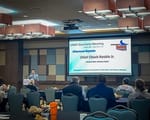
DURANT, Okla. – The Federal Aviation Administration (FAA) proposed a new rule Tuesday that addresses and enables Beyond Visual Line of Sight (BVLOS) operations for drones, also called unmanned aircraft systems or UAS. This is part of larger efforts to safely integrate new emerging aviation technologies into the national airspace system.
This proposed regulation will usher in new opportunities for facilities like the Choctaw Nation of Oklahoma’s (CNO) Emerging Aviation Technology Center on Daisy Ranch, and more broadly, the CNO reservation.
The CNO Emerging Aviation Technology Center is a one-of-a-kind test facility in southeastern Oklahoma that utilizes 44,600+ acres of remote, tribally owned land. The facility supports innovation in emerging aviation technologies, including drones and advanced air mobility technologies.
“This Part 108 rule enables regulation that will allow the United States to have a path toward safe and normalized operations of drones,” said James Grimsley, executive director of advanced technology initiatives for CNO. “This is one of the biggest leaps forward in FAA regulations to address this emerging technology in decades. We applaud the FAA for bringing the Part 108 rule forward.”
Previously, drone operators were required to request individual waivers or exemptions to operate drones for BVLOS applications. These were approved on a case-by-case basis, and the process was cumbersome and expensive.
“Package delivery, agriculture, surveying, innovative healthcare and public safety are just some of the uses we expect to see grow in the UAS space as a result of eliminating previous restrictions,” said Grimsley. “We’re looking ahead to all the additional research and development we will be able to do under these guidelines.”
The proposal also includes a clear regulatory path for manufacturers, operators and UAS traffic-management (UTM) services to keep BVLOS operations safely separated from each other and legacy manned aircraft.








